William Wayne Weems
© Copyright 2003
by William Wayne Weems

(“Flappers? Us? Who are you calling flappers?”)
| Effeness
William Wayne Weems
© Copyright 2003
by William Wayne Weems
|

(“Flappers? Us? Who are you calling flappers?”) |
October 4, 1951.
The Maxwell House Hotel in Nashville, Tennessee is the location of a live radio broadcast. The host of the show claims to be puzzled by the name of the club to which many of his female guests belong. He is informed that the name of the Effeness club is an acronym for “Every Friday night sewing club”. He also soon learns that this day is their twenty-third anniversary as a club.
He asks Katherine Roth Pearce how
the Effeness club was
started. She says it started with a little country girl from
Clarksville,
Tennessee....

(“I had a perfect attendance record too”)
Once in Nashville she found she had no friends there, so she decided to start a club.

(Isn’t that Thelma Neal at the desk? And the pretty one standing on the right is Edna Wood (later Dennis) who joined in the early years and was a club member for a long time).
Also a cousin, Vera Saunders, came into town and was all for the idea of forming a club. So members at the initial meeting of the Effeness club were the new arrival from Clarksville, Cecil Pearl Davis (later Weems), her cousin Vera Saunders (later Douglas), Madge Harper (later Graves), Mildred Pitt (later Parsons) and Mamie Odom (later Matthews).
We met last month with Edna Earle
And wished a happy birthday to the club
Although to think how old it is---
Really brings a rub!
Everyone was there you know
Except we missed Mamie a lot
When one of us is absent
The rest sort of goes to pot!
Cecil had a little business
And Annie collected our money---
She also told us what we had---
As a treasurer she’s a honey!
Most of the girls looked awfully cute
All in their new fall dresses:
They were primped from head to toe
With even new curls in their tresses.
Edna Earle had some contests
Which really took us back
To the time when we were quite young---
Some few years ago, for a fact!
The contests would have been more fun
Except the ice cream got runny---
So the hostess ended them right quick
Which wasn’t very funny.
The table had a birthday cake
All centered with green and white
We’re glad we’re Effenessers
It’s truly a delight!
It isn’t just a social club
Or a club that’s meant to make money;
Altho we deal in rummage
Until sometimes it isn’t funny!
We like to think that this, our club,
is mostly made of love,
and we ask only to be together
To feel we’re blessed from above
May the years that are in front of us
Be as good as those in the past;
And may the love in all our hearts
Last and last and last and last!
And so club meeting was over
We always hate to go:
But we’ll meet with Thelma the next time
And I hear it’s gonna snow!
 |

(Seventy years ago we could make any costumelook good!) |

(So it is little and crowded. Hey, hard times.)
 |
 |

(At last, a real car! Now we can take many long trips!)

(Welcome to Camp Sycamore. No, we don’t swim in these outfits, even if it is 1932).
 (Roy Carothers in 1931: “Hey, except for swimming
|

(1935: “We girls revolted at doing all the cooking |

(Of course, the girls loved to clown for the camera in 1935)

(Check this out, Osama.. .oops, its 1933 ....we
|

(Sure, we all work together for a successful
|

In the late 1940’s Claude Pearce completed work on what he called his “camp” on what is now Pennington Bend Road. The Pearces owned another house across the river in Inglewood but at that time convenient access was available through the regular service of the large “Judge Hickman” ferry which crossed the Cumberland to the low bank at McGavock Pike. Of course, the “camp” itself was on the low bank downstream on the Cumberland from the confluence of the Stones River; neither of these rivers were constrained by hydroelectric dams at the time and flooding was a regular fact of life at the “camp”. Most of the large furniture there was of the sort placed on patios of the period, with cushions over rope frames and large wooden wheels to aid in moving the items about. The camp itself was of sturdy log construction with exposed ceiling beams inside. When a big flood was expected furniture cushions were flung over the rafters and delicate items like the early square screen Zenith television (it took 12 to 18 separate adjustments to change channels, and children were forbidden to touch it) were actually suspended from the rafters by ropes.
 |

(Probably Claude hoped to avoid the number of
|
The worst effects of river flooding were the destruction of Claude’s boat docks. For many years a restaurant sat alongside the Cumberland about where the Briley Parkway bridge stands. An unusually broad and gently sloping river frontage caused the developers to build facilities there for swimming and boating. The entire facility was called “Woodale Beach”. Claude had more than one inboard engine wooden Chris-Craft power boats over the years, each of which he named “Kitty”. But the lower river bank at the camp was much too steep for easy boat access. So, inspired by the facilities at Woodale Beach, Claude built a wooden staircase there down to a floating boat dock at the water’ s edge where he hoped to keep his “Kitty” boats ready for use. Floods carried the whole thing away. Claude then rebuilt the staircase and dock with stronger materials, but ultimately this was swept downriver too. While boating activities continued at the “camp” there were no more staircases or boat docks constructed.
The best feature of the “camp” to some in those days before universal air conditioning was the large roofed and screened-in rear porch or deck. One could usually catch the river breeze there without the bother of insects, so that was where most meals were served.
 |

(Not every entertainment at the river camps
|
Later on a large permanent barbeque pit was added at the southern end of the “camp” property, and on long fourth of July and Labor Day weekends Otto Cato would spend all night on a cot beside the glowing coals, rising on occasion to see how the meat was cooking. Many of the club families would keep him company by spending the night on folding beds at the “camp”, usually preparing things like hand-cranked (and truly fresh) ice cream.

(At the camp in 1960) |

(In 1957) |

(“Candy” and Claude, 1957) |

(Another group shot from 1960) |
Otto Cato would be miffed if we failed to mention the Bordeaux Civic Center, which he helped construct in the days when all hoped for a bright future for the little community across the river from North Nashville. He was able to get that building for the club’s cold weather parties, such as their New Year’s party.

Trips to distant locales (above, Lookout Mountain) were seldom made by the club as such, but rather by two or more club members traveling together. Perhaps the only exception was the 1965 charter of a bus for a day trip to Mammoth Cave in Kentucky. It was just too difficult to synchronize so many individual schedules for so long an absence at the same time; hence the beauty of the camp experience, where people could come and go when they pleased and stay for what time they had.
 |
 |
 (Florida, with charter member Vera in the “back seat”.
Vera would stay in Florida until 1998)
|

(Florida, 1936) |

(Not Shirley Temple but Cecil’s niece Sue, 1939) |
Still, they went on trips, most notably before the second
world war curtailed travel and before the prosperity the war bought made
possible the realization of previously deferred dreams of children of one’s
own....which despite their many blessings do tie one down.
|

(Symbols of the 1939 New York World’s Fair) |
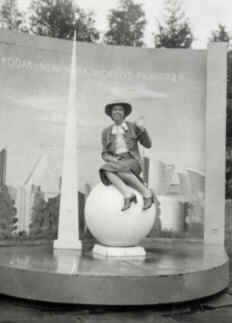
(Which Lena rides with aplomb)
|

(Annie knew if you go in the train in 1940, you go in style)
|
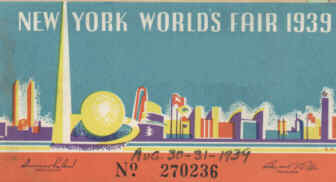 |
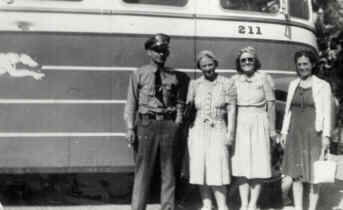
(“Leave the driving to us” 1940 style. Ethel Lusty
|

(And away-y-y-y we go!) |
A great many Effeness club members joined a special train organized by the Inglewood Baptist Church in 1958 to see the Billy Graham crusade in New York City. Ample sightseeing time was allowed in the tour. The train was 22 passenger cars long.
The husbands of Effeness club members had a major impact on their selection of trip destinations, one of the few instances in which males made a significant difference in their social agendas. The men discovered the little fishing village of Carrabelle on Florida’s Gulf coast. An ambitious and hard-driving captain named Anderson took his passengers perilously far into the Gulf of Mexico to previously undiscovered fishing grounds. The size of the fish caught there was eye-popping by Tennessee standards.
Panama City had world-class beaches, plenty of shops and
entertainments, and so many people that Captain Anderson soon built much
bigger boats. The ladies were delighted and came along whenever they could.
But when they tried going out to sea on the bigger boats, they still remained
seasick for the whole voyage.
 (“Goofy Golf” a miniature golf course with outlandish
painted concrete decorations) |

(Panama City, 1960) |

1960 |
 (Is time beginning to tell on the “girls”?) |

1968 |
During this entire period monthly meetings continued, along with all the stresses and trials of ordinary life, so with their 40th Anniversary it is perhaps not too surprising that the club members began to slow down a bit. And father time was giving another pointed reminder of their progress as their own children began to get married. (Lena and Otto Cato had one child, a daughter named Brenda; Cecil Pearl and Sam Weems one child, a son named William Wayne; Earl and Frances Compton two boys, Reavis and Jerry; and Mamie and John Matthews one son, who they named John L. Jr.)

(Marriage of Jean and John L. Matthews, Jr.) |
 |
The response of the Effeness ladies to the courtships and weddings of these “club children” was interesting, to say the least. Two, Annie Baggott Cathey and Thelma Neal, decided to get married again themselves.

(Thelma and Russell Vardell) |

(Annie and Logan Pruitt) |
Willie Mae Shockley also married A. L. “Bud” Rust after the death of her first husband, Marion Shockley.

(The ladies of the club, 1972)
With the approach of the Club’s 50th Anniversary time began to force still more changes upon the activities of the members. After the completion of Old Hickory Dam and Percy Priest Dam the Army Corps of Engineers declared the Pennington Bend area to be free of any but the most extraordinary floods. The new Opryland complex began building there, Cecil and husband Sam moved there, then Katherine Pearce and husband Claude built a new home next to their old camp buildings, which they ultimately sold. The Corps then blew up a low flow-over dam and navigation locks at the tip of the Bend. The Metro Government of Nashville and Davidson County made a park out of the plot of land that had included the lock keeper’ s house. Lock Two Park became a favorite picnic spot for the club.
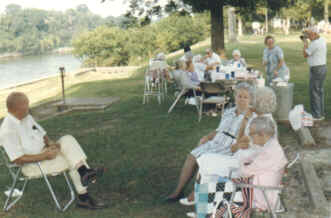 |
 |
But the Corps of Engineers did not drop the lake level in the reservoirs created by its new dams when spring came as TVA did. Some say they were pressured by wealthy lakefront home owners. In any event, when record rains fell in 1975 all they could do was open the floodgates on their dams and let the water through. The new Opryland theme park was devastated, and water rose to the ceiling of the furnished basement of the new Pearce home. They were forced by loss of power to ride out the flood in the Weems home, where the basement was only partially furnished and partially flooded.
Clearly, the sale of the Pearce camp on Pennington Bend Road and the death of Claude Pearce in 1976 marked the end of an era. Yet Lena’s Sister, Sadie Smith and her husband Lawrence now had more time to devote to the activities of the Effeness and their “Friendly Fourteen”, and Claude House was likewise seen more often in club gatherings.


(Roommates. 1987)
 |
(Why did we think picnics a lot of trouble? Well, here we are at the Weems riverfront home in 1988, there has been a cloudburst, and we had to drag tables and all into their unfinished and cluttered basement!) |
 (Look at Lois’ granddaughter Kristi Joy, second
|
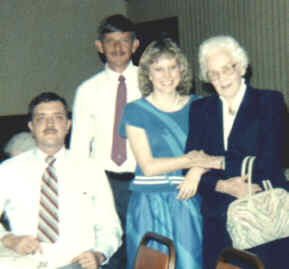
(And in this 1986 photo) |

The new Carney home, its broad covered garage ideal for picnic style meals) |

(Ethel Lusty’s common dining room in her assisted living facility, which she could reserve with complete meal services for herself and her guests. A big problem was finding an unlocked door at the building’s ground level.) |

(Valentine’s Day, 1994) |

(Christmas, 1995) |

1992 |

2002 |

(25th Anniversary, 1953)
|
Invocation........................................Rev Bunyan Smith Welcome.............................................Edna Earl Carney Piano Solo............................................Nancy Strausser Introduction Of Members
Guitar Duet....................................................Jim
Ralston
History Of The Club..........................Mamie Matthews Solo.............................................................Joyce Collins Cutting Of Anniversary Cake.........Cecil Pearl Weems Assisted By..............................................Annie
Cathey
Refreshments |
Serving Nieces Of The Club Members Sue Carroll Jones Jacqueline Fleming Dolores Jones Joyce Collins Sylvia Draper Anna Marie Cartwright Annie Ruth Cartright Betsy Simkins Dorothy Elaine Reed Glenn Ann Keith Judith Odom Joan Startup Carolyn Startup Martha Grizzard Hilda Pruett
|
IN MEMORIAM
EARL COMPTON JUNE 23, 1972
AND MANY OTHERS WHO LIVE ON IN OUR MEMORIES
AND IN OUR HEARTS |
(Messages are
forwarded
by The
Preservation Foundation.
So, when you write to an
author,
please type his/her name
in the subject
line of
the message.)
The Preservation Foundation, Inc., A Nonprofit Book Publisher